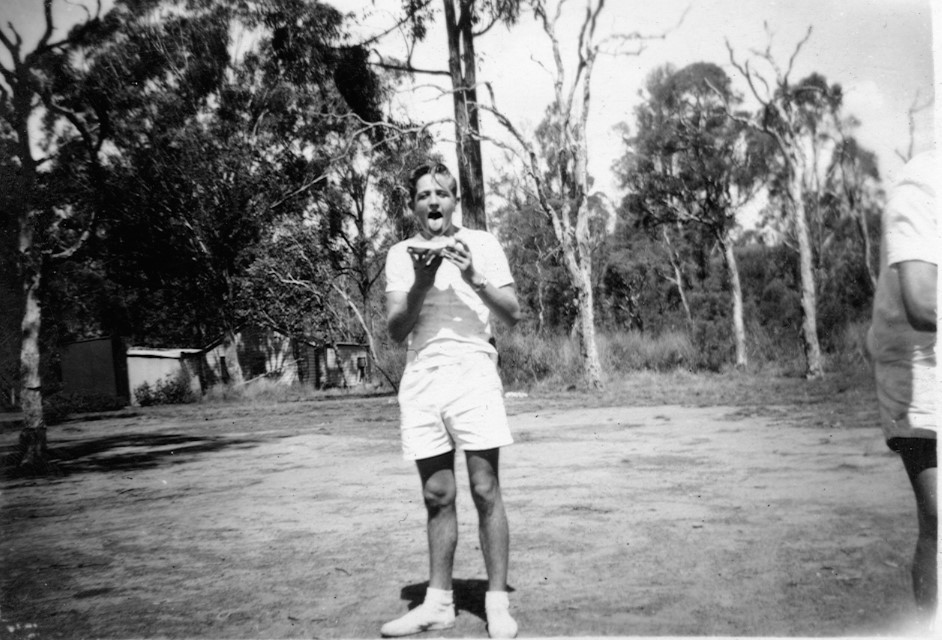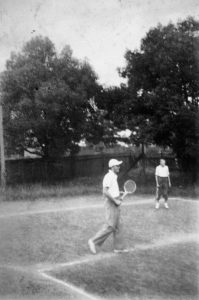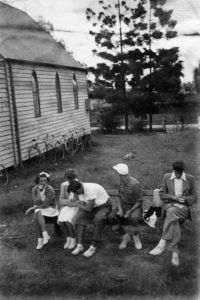by Heather Smith
In the 1950’s when I was a young girl growing up in Riverstone – tennis in Australia was at its peak and nowhere more so than in Riverstone. Tennis filled a social and competitive role for many of us teetering on the brink of adulthood. Television, computers, clubs and pubs were an unknown quantity to us in those days – our entertainment was self made and tennis could keep a young person very busy for the entire weekend.
The Presbyterian court located in the centre of town on the corner of Garfield Road and Oxford Street was a meeting place for many of us during the school holidays.
Geoff, Ernie and Warren Nichols when they could get away from the family business, the Leach girls Joyce and Fay, Geoff Follett, Leon Turner and I spent many hot and happy afternoons bashing away at a tennis ball. Our only refreshment came from the tap outside the court – the boys drenched their heads while we girls drank daintily from the end of a hose.
On Sunday afternoons we pedalled our bikes or were doubled the three miles (five kms) to “The Groves” Picnic grounds on Windsor Road at Mulgrave. Situated here were two tennis courts, a number of small shelter sheds and a shabby old house which was known rather grandly as the tea rooms.
Brian Woods, John and Lynnie Waters, Kevin Lewis, Colin Crouch and I thought nothing of the long ride out there. Sometimes we struggled out with a large watermelon which was cut up with a pocket knife and then shared around. Kevin Lewis recalls one afternoon that finished in a water melon fight and alleges that Johnnie Waters pushed one into my face for letting down his bike tyres. (The author hotly denies both incidents.)

Photo courtesy of Heather Smith
At the end of the day I was always grateful when my father turned up in his 1949 Ford utility and Lynnie and I rode home in the back while the boys raced behind on their push bikes, back home to Rivo!
Sadly both of these courts have disappeared, the land gobbled up by progress. A church and parking area now replaces the Presbyterian court and on the site of “The Groves” picnic ground there is a large brick building which has seen life first as the Tourist Centre then “The Black Stump” Restaurant, but now seems to be just a vacant building.
Gradually the Robbins’ family took me under their wing. In 1949 Joan Robbins and Beryl Penrose won the Australian Ladies Doubles Championship. Three or four times a week I was coached by Joan in the finer points of tennis.
Ozzie Robbins maintained an excellent court in Oxford Street just past the intersection of Regent Street. The red sandy loam used to top dress the court was obtained from the council owned land on the corner of Bourke Street Richmond. The only remaining evidence of this is the large hole filled with water and now the water hazard on the Richmond Golf course. I then began to play more competitive tennis with the Robbins family, Mr and Mrs Robbins, their daughters Joan and June and the Gavin boys Geoffrey and Ron.
Each court was very proud of their competition teams who competed in the Saturday afternoon District competitions. I had been invited to partner Eileen Martin and together with Keith Martin, Darcy Moulds and the Gill boys Harold and Cecil, we represented Wilmar court. The Saturday afternoon competition followed a strict order of play. Each team comprised of four men and two ladies and they played sets of first to six or more with an advantage of two games. Each of the games were Doubles. First to play was the Men’s Doubles followed by two sets of Mixed Doubles then the Ladie’s Doubles. Following afternoon tea the reverse order of Mixed Doubles was played and finally the reverse Men’s Doubles. Each player had completed three sets and the winning team result was based on the best of nine sets. At the end of the season if any two teams were on equal points a count back of all games won during the season separated the two teams.
Afternoon tea, supplied by the home team, was always a source of pride. It was here that the best cooks of the District came to the fore – scones and pikelets with jam and fresh cream, recess cakes filled with jelly and cream, double sponges so high it took an enormous bite to contain the double layers, sandwiches and savouries always accompanied by endless cups of tea poured from large enamel or aluminium tea pots.
Another custom strictly adhered to in Saturday afternoon competitions was all tennis clothes were white or cream. The older men wore long sleeve white cotton shirts and long flannel trousers. If the game became too physical they sometimes rolled up their sleeves. The older ladies were suitably attired in a white dress reaching past the knees and quite often stockings. Both ensembles could be finished off with a white canvas hat or sun shade.
The younger generation prided ourselves on being much more adventurous. The young men wore white shorts and short sleeve cotton T-shirts, gold watches on sun tanned arms and hair slicked back and held in place with ‘California Poppy’ or Brylcream.
We girls wore white dresses with pleated skirts which were steam pressed each week using a very hot iron over a damp cloth. When they blew up following a more strenuous passage of play spectators were given a glimpse of frills and lace….Gorgeous Gussie panties. A daring trend introduced at Wimbledon by an American female player Gussie Moran whose underwear featured rows and rows of gathered frills and lace. Sewing machines all over the district whirred away stitching frills to daring young tennis players’ panties.
White canvas sand shoes and white cotton socks completed our ensembles. We favoured white Dunlop Volleys with rubber soles and after an afternoon of play on courts of orange loam the socks and shoes generally ended up the same colour. A vigorous scrubbing with a brush and Sunlight soap usually removed the stains from the shoes followed by a liberal application of Nugget white shoe cleaner. Sometimes the shoes had to be dried in the oven. If I forgot to do them through the week and if they required quick drying on the morning of competition, I had to resort to the oven of my Mother’s ever faithful fuel stove, kept a-going in all weathers. Usually a smell of burning rubber coming from the kitchen announced that they were ready for wear. The white socks took a little longer to restore to their whiteness. They were rubbed, soaked and boiled, then a liberal rinse in the blue water could bring them back to pristine whiteness.
Gradually I progressed to A grade competition and partnered Claudette Atkins and teamed with ‘Darkie’ Hall, ‘Curley’ Shepherd, Barry Blundell and Trevor Edwards who drove me to the matches each Saturday in his Vauxhall Velox, often balancing my Mother’s carefully prepared contribution to afternoon tea on my lap. Every week I stood nervously at the net as serves from the strongest players in the competition whistled past me each game, but somehow I managed to survive and we won the A Grade.
In 1956 I was married and settled in Riverstone. My husband Kevin was also a keen player who came from Oakville so I played a few seasons there. Oakville had two excellent courts maintained by his uncle Dick Baker on the ground where the Oakville Cricket field is now located.
In the mid 1950’s two courts were constructed in the Meatwork’s paddocks complete with lights. One night a fund raising exhibition match was played there and one of the players was a very young John Newcombe. A strong Sunday morning competition was held there also and was won by the team of sisters Merle Banks and Joyce Foster Lawson Banks, Colin Moulds, Kevin Smith and Trevor Edwards. Ken Foster, Joyce’s husband, was the reserve player.
Racquets were of the assorted variety, wooden frames with cat gut strings. Some of the most popular brands were Slazenger, Oliver Bluebird and Cressy Perfect which were screwed into wooden presses to stop the frame from warping. In 1949 I won a school girl championship and my Father bought me a top of the range Dunlop Maxply costing five pound equivalent today of approximately $10.00. I played with this racquet for over ten years without replacement.
With the advent of lighted courts becoming more popular in the District, night competitions were played all through the summer. This was the opportunity for married couples with children to team up for a night out together and often there would be a line up of prams and strollers outside the perimeter of the court with the off duty players tending to the children.
There were many wonderful Riverstone tennis players. I remember in my generation Marcia Bowd, Ron Cusbert, the Drayton boys George, Alan and ‘Butch’ Drayton, Harry Phillis and Jack Weaver. Tennis was a favourite game of Riverstone sportsmen and women and I hardly knew a person in my day who did not play.


